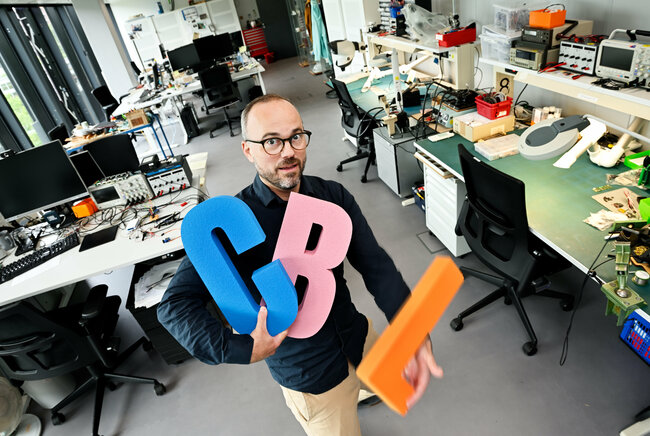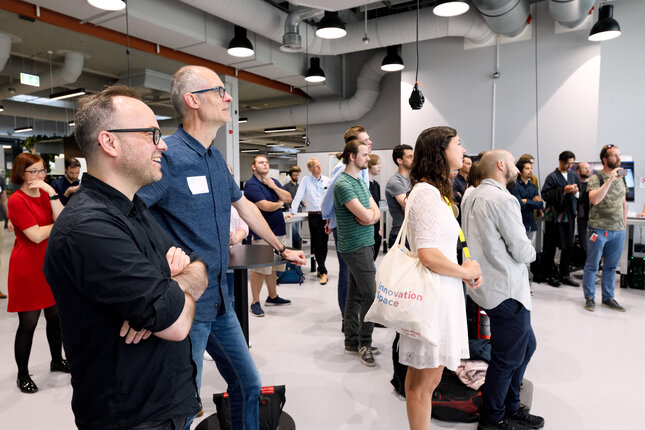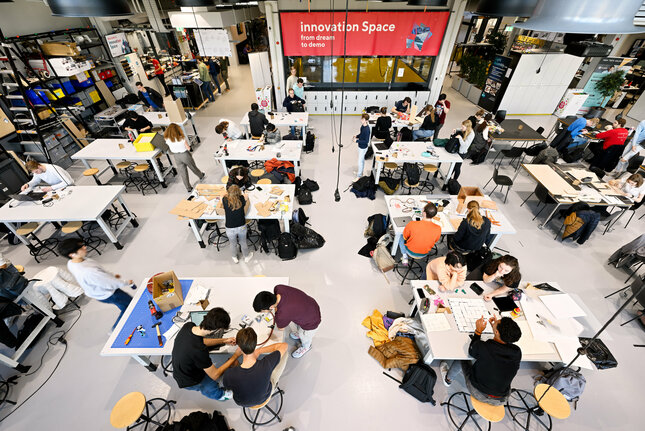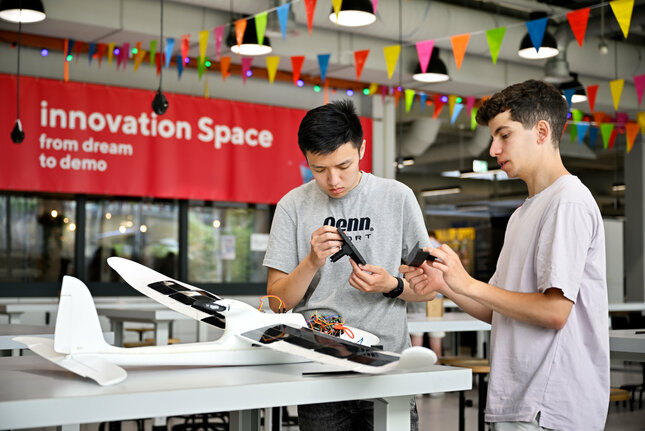‘Challenge-Based Learning dares teachers to let go'
‘The Faces of Challenge-Based Learning’ series: Educational innovator Miguel Bruns (Industrial Design) has been working on CBL throughout his career.

With the innovative educational concept of Challenge-Based Learning (CBL), we are training the engineers of the future at TU/e. Starting this academic year, CBL will play a larger role in the curricula of all our bachelor's programs. Through a series of stories, we give a face to the form of education that sometimes takes students - and teachers - out of their comfort zone, but above all prepares them for the challenges they will tackle as engineers. In this episode: Miguel Bruns, one of TU/e's CBL pioneers and co-founder of TU/e innovation Space.
Miguel Bruns has big dreams and ambitions for our students, the engineers of the future. “Students will soon no longer come here for a degree in Biomedical Engineering, but because they want to develop new materials or improve health care, for example. Thanks to Challenge-Based Learning, here they can develop themselves into the great innovators of the future.”
At the start of the new academic year in September, the Bachelor College 2.0 will be rolled out, with Challenge-Based Learning (CBL) taking on a larger, university-wide role in all curricula.
What is Challenge-Based Learning?
In this innovative educational concept, students work together to experience how their discipline can contribute to solving challenges from the world around us. They learn what knowledge and expertise is needed to do so and can immediately apply and deepen the knowledge they have acquired in practice by studying or doing research.
Together with students from other disciplines, as well as stakeholders from business, government or science, students learn to think at the system level. In the process, they also learn various other competencies such as collaboration, communication, planning and organizing.
Ready for more CBL?
“Are we ready for more CBL starting in September?” wonders Miguel Bruns, thinking aloud. “I think a third of our teachers are,” says the associate professor at Industrial Design and one of TU/e’s CBL pioneers. That number doesn’t seem like much, but Bruns still considers it acceptable. “It just takes a small but motivated group to convince others.”
Therefore, Bruns is not inclined to attach a fixed percentage to how much CBL will be taught in undergraduate courses starting in September. “Between 20 and 80 percent is fine. It should be up to the departments themselves to determine exactly how much.”
Bruns is not only enthusiastic but is also a realist. “You should not expect all teachers to be equally committed and lavish with it or embrace CBL completely. It is not a teaching concept that immediately fits all subject areas. Some subject areas require more theoretical knowledge, so more traditional forms of teaching are more appropriate. This applies more to certain math and physics subjects, for example, than to experimental and design subjects,” Bruns notes.

TU/e offers a wealth of knowledge and opportunities, let students sample as much of it as possible.
Miguel Bruns
Teachers are given a very different role with CBL: that of coaching students, both individually and at group level as they work on CBL challenges. “I believe you should introduce students to as many facets of our university as possible in their first year. TU/e offers a wealth of knowledge and opportunities, let students sample as much of it as possible.
“I know that not all students in their first year already know what they want to do, but it is a question to ask them. Because then they start thinking about it. If you don't ask them where their passion or ambition lies until their master’s project, it's too late.”
From passion to knowledge
“Where does your interest lie? Where would you like to work later? Do you have a passion for automotive, sustainable building, algorithms and AI, 3D printing, for example? The role of the coach is to point students toward the right courses to gain the knowledge needed to get started with their passion. That can be from anywhere, at different departments or at one of our four institutes."

CBL means letting go and daring more. That requires a change in mindset.
Miguel Bruns
“It’s no longer just about conveying your disciplinary knowledge; above all, you have to show students the way and help them find direction. It means letting go and daring more. That requires a change in mindset.”
Industrial Design as a foundation
The former program director of the Industrial Design department has a lot of experience with Challenge-Based Learning. “I have been working at Industrial Design for fourteen years now, where teaching was actually always done in CBL form, although it wasn’t called that at the time.
“Students were given a project assignment and had to find the necessary knowledge for it themselves. In a portfolio they had to indicate what they had learned,” he says, sitting at a table on floor 4 of Atlas, overlooking innovation Space, the TU/e expertise center for CBL and entrepreneurship.

“The structure at ID was very open. Before the introduction of the Bachelor College (in 2012, ed.), we were asked to translate that form of education into an educational concept in which students from other departments could also participate.” That was the starting point of Challenge-Based Learning at TU/e.
Aalto inspo
“Together with Isabelle Reymen (now scientific director of TU/e innovation Space, ed.) and Rick de Lange (now professor of Mechanical Engineering, ed.) I set to work on forming an educational vision to bring CBL to the entire university,” Bruns explains.
During a study trip of program directors to Aalto University in Finland, they were inspired by the innovative ecosystem for education and entrepreneurship - with a startup sauna and Design Factory. This was the spark from which innovation Space, the expertise center for Challenge-Based Learning and entrepreneurship at TU/e, was born. You can read more about innovation Space in the interview with Isabelle Reymen in this series on CBL.

The best way to learn
Bruns realizes that his experience at Industrial Design gives him an edge over other teachers. “If you haven’t worked that way with students for years, it won’t just happen overnight. It takes time.
“Students do find their way, in my experience. You don’t have to worry about them missing out on important disciplinary knowledge. As soon as they notice that they need certain knowledge for an assignment, they go for it. They see what they need it for and can use it for, and that’s the best way to learn.”
Strawberries
Bruns gives an example. “Suppose you have a passion for improving agriculture through technology and you want to develop a strawberry-picking machine. So how do you approach your studies? You need knowledge of robotics; you need to learn how to process data to arrive at pattern recognition so that your device can distinguish a ripe strawberry. The pressure of the gripper picking the strawberry has to be variable, because you don’t want it to crush the fruit.”
He continues. “You'll take courses at other departments, or maybe an elective at Wageningen in food technology. A gripper can be made of metal, but you might want to make one out of a soft material. A subject like Systems and Control, for example, is important. You need to know about differential equations; you also need this for pattern recognition. And that’s where calculus comes in, for which there are components on offer.
“It’s a different way of looking at your studies. It’s no longer a matter of taking all the courses in a specific order but looking at what you need to solve the challenge.”
You have to take small steps. See how you can add a little CBL within the context.
Miguel Bruns

A little CBL
“We need to make a big push, because there is still a lot of ‘old’ thinking,” Bruns says. That’s why he thinks it’s important not to completely turn curricula on their head. “You have to take small steps. See how you can add a little CBL within the context. Start with a small project that teaches students to make more choices for themselves, but in a controlled way so you can make use of your knowledge and skill.”
Listen
Bruns regards the resistance he sometimes encounters from teachers as a challenge - in much the same way challenges are ingrained in CBL education. “Sometimes I had had enough of it for a while, but it wouldn’t let me go. Then I went back to the drawing board. If I can convince a few more teachers, I’m happy. I have a vision and ambition and I’m sticking to it. If I can’t achieve it in one year, then it will be in five or ten years.”
Student in the lead
Bruns is an education innovator pur sang - he always sees room for innovation and improvement. Inspiring students and thereby allowing them to learn for themselves is what he is all about. “To give students direction, we need scientists who can tell stories. Who excel at their discipline and who are open to conversation. Who know what is going on and who can make clear what knowledge and expertise is needed to arrive at a relevant solution.” And, as Bruns knows, that transcends departments.
“We have many top researchers at TU/e. Let them enter the discussion with students to inspire them. What can you do with this technology? By introducing them to research early on, you let students experience what knowledge and skills they can use to solve societal challenges.”
Keep innovating
Bruns is not currently focusing on the organization of teaching; the associate professor is concentrating on his research in the Future Everyday group at Industrial Design. “Although, of course, I will continue to do my teaching in CBL form,” he concludes as a simple statement of fact. “Because by having students think along with my own research challenges, they inspire me and I too continue to innovate.”
More Faces of Challenge-Based Learning
More on our strategy


![[Translate to English:] [Translate to English:]](https://assets.w3.tue.nl/w/fileadmin/_processed_/c/f/csm_BvOF_2024_0319_AEV_license_TUe_Dirk_van_Meer_-_CORE_1__c976e259a5.jpg)
